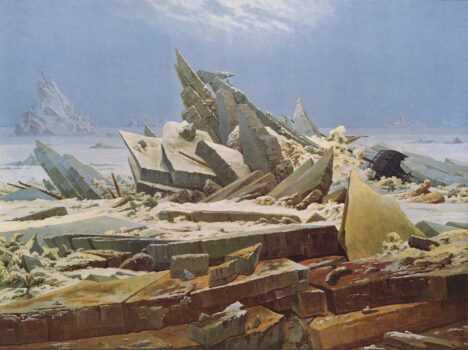The Sea of Ice by Caspar David Friedrich
Caspar David Friedrich, one of the leading figures of German Romanticism, is best known for his evocative and introspective landscapes that often explore themes of nature’s power, human fragility, the sublime, and spirituality. Among his more dramatic and haunting works is The Sea of Ice (also known as The Wreck of Hope), a painting completed between 1823 and 1824.
Unlike Friedrich’s more meditative pieces featuring lone figures contemplating nature, The Sea of Ice is stark, violent, and desolate. It captures a moment of nature’s indifference to human ambition and survival. The painting is a masterclass in expressing the sublime, not merely beauty, but the terror and grandeur of nature that dwarfs human effort.
What is Happening in the Painting?
At first glance, The Sea of Ice presents a chaotic, almost abstract composition of massive jagged ice slabs rising dramatically in the Arctic landscape. These sharp, darkened shards of ice have thrust upward as if from a violent convulsion of the Earth, forming a towering, splintered pyramid in the center.
Among the ice, the fragmented hull of a wooden ship lies crushed and half-buried. It is barely visible, overwhelmed by the monumental natural elements surrounding it. The sky above is pale and cold, contributing to the painting’s mood of isolation and desolation.
There are no people visible in the painting, no animals, no signs of life or hope. Everything is static yet filled with implied motion: a frozen instant of devastation. This visual stillness contrasts with the latent energy of the scene, the movement that led to the destruction of the ship, and the slow, inevitable march of the ice.
What is the Painting All About?
The Sea of Ice is about the triumph of nature over human ambition. The painting’s alternate title, The Wreck of Hope, points explicitly to this theme. Friedrich conceived of this work in the context of early 19th-century Arctic expeditions, particularly those seeking the Northwest Passage. Many such ventures ended in disaster, with ships trapped or crushed by sea ice, and crew members dying from exposure, starvation, or isolation.
However, Friedrich does not merely illustrate a particular historical event, he transforms the theme into a timeless meditation on nature’s sublime power and man’s insignificance in the face of it.
Romanticism often emphasized the tension between human beings and the natural world. In this painting, Friedrich strips away the comforting pastoral or picturesque elements seen in other Romantic works. Instead, he offers nature in its most brutal, alien, and indifferent form.
Visual Analysis
Let us break down the painting’s elements for deeper interpretation:
Color Palette: Cold and restrained, composed primarily of whites, grays, and icy blues. These colors emphasize the frigid, lifeless setting.
Composition: The painting is vertically oriented, leading the eye upward from the wreck at the base toward the towering ice forms. This composition underscores the overwhelming dominance of nature.
Light and Shadow: Light is diffused and ambiguous, providing no warmth. Shadows among the ice create a sense of depth and menace.
Perspective: There is no central vanishing point or traditional linear perspective, which contributes to the sense of disorientation and chaos. The lack of human scale or clear horizon enhances the sublime effect.
The Shipwreck: The ship, half-consumed by the ice, is both a narrative element and a symbol. Its fragmented state signifies lost ambition, shattered hope, and human vulnerability.
Symbolism and Interpretation
Friedrich was deeply influenced by German Romantic philosophy, especially the ideas of the sublime articulated by thinkers like Edmund Burke and Immanuel Kant. The sublime, in this context, refers to the overwhelming, awe-inspiring, even terrifying beauty of nature, which both humbles and elevates the human spirit.
Here are key symbols and their interpretations:
1. Ice as a Force of Nature
Ice, in Friedrich’s painting, is not merely a physical substance; it represents the cold, impersonal power of nature. It is unfeeling, unrelenting, and unstoppable. Unlike a tempestuous sea or a volcanic eruption, both of which are momentary and dynamic, ice is slow, methodical, and permanent. It destroys not in a moment, but over time, crushing human endeavors under its weight.
2. The Shipwreck: Shattered Human Ambition
The shipwreck symbolizes failed human enterprise. In an era when Enlightenment optimism and technological advancement were celebrated, Friedrich’s painting is a stark counterpoint. He reminds us that there are limits to human conquest, especially in the face of nature’s vast, ancient rhythms.
3. The Absence of Humanity
Notably, no people appear in the painting. This absence emphasizes human helplessness. The viewer is not a participant in the scene but an observer, confronted with the outcome of tragedy. The emptiness amplifies the sense of isolation and the finality of nature’s dominance.
4. The Title: The Wreck of Hope
The alternative title hints at deeper psychological and philosophical themes. “Hope” is not only the lost name of the ship but a metaphor for Enlightenment ideals, human ambition, and perhaps even faith itself. Its wreckage beneath the ice becomes a metaphor for disillusionment or existential despair.
Historical and Cultural Context
Romanticism and the Sublime
Romantic artists like Friedrich reacted against the rationalism and order of the Enlightenment, emphasizing emotion, individuality, and the power of nature. The sublime, a central Romantic concern, is about being overwhelmed by greatness beyond comprehension, whether terrifying or beautiful. The Sea of Ice is a quintessential expression of the sublime in art.
Scientific Exploration and National Ambition
In the early 19th century, European nations, especially Britain and Germany, were obsessed with exploration. The Arctic was one of the last uncharted frontiers. While these expeditions were celebrated as heroic, they were also marked by loss and failure. Friedrich was acutely aware of the darker side of exploration: the cost in human lives, the hubris of imperial ambition, and the vulnerability of man.
Friedrich’s Personal Philosophy
Caspar David Friedrich was a devout Lutheran with a melancholic disposition. Many of his works deal with themes of death, loss, and spiritual yearning. He believed that art should be a vehicle for deeper contemplation. In this sense, The Sea of Ice can also be read as a meditation on death and the soul’s confrontation with the infinite.
Technical Aspects and Artistic Choices
Medium: Oil on canvas.
Size: 96.7 cm × 126.9 cm (approximately 38 inches by 50 inches). Despite its modest size, the painting achieves monumental impact through its subject matter and composition.
Technique: Friedrich’s precise brushwork and attention to detail give the ice an almost crystalline clarity. The jagged shards appear sharp enough to cut. He layers cool tones to create depth and volume within the ice.
Reception
When Friedrich painted The Sea of Ice, it was not well-received. The stark, bleak subject matter was out of step with popular tastes. The German art world, increasingly drawn to Classical and Biedermeier styles, had begun to turn away from Friedrich’s intense spiritual Romanticism.
However, in the 20th century, the painting was reappraised as a masterpiece. Its modernist abstraction, psychological depth, and environmental resonance have earned it a place as one of Friedrich’s most significant works. It influenced artists like J.M.W. Turner and later German Expressionists.
In contemporary times, The Sea of Ice is often viewed through ecological and existential lenses. It resonates with concerns about climate change, human vulnerability, and the limits of progress.
Where is the Painting Now?
The Sea of Ice is currently housed in the Kunsthalle Hamburg (Hamburger Kunsthalle) in Hamburg, Germany. It belongs to the museum’s rich collection of 19th-century German Romantic art.
The painting is displayed prominently, often surrounded by other works of Friedrich and his contemporaries. It is a centerpiece of the museum’s Romantic gallery and attracts visitors from around the world interested in art, philosophy, and environmental themes.
Caspar David Friedrich’s The Sea of Ice is a haunting meditation on the power and indifference of nature. It stands apart from his more serene works, offering instead a vision of destruction and futility. But far from being nihilistic, the painting invites contemplation. It asks the viewer to confront their place in the universe, not as a master of nature, but as a small, transient being within it.
Through its symbolism, composition, and thematic depth, The Sea of Ice encapsulates the Romantic sublime. It warns against hubris, honors the majesty of the natural world, and encourages introspection. Even today, two centuries after it was painted, it remains a powerful and resonant image, a testament to Friedrich’s enduring genius and the timeless questions he posed through art.




